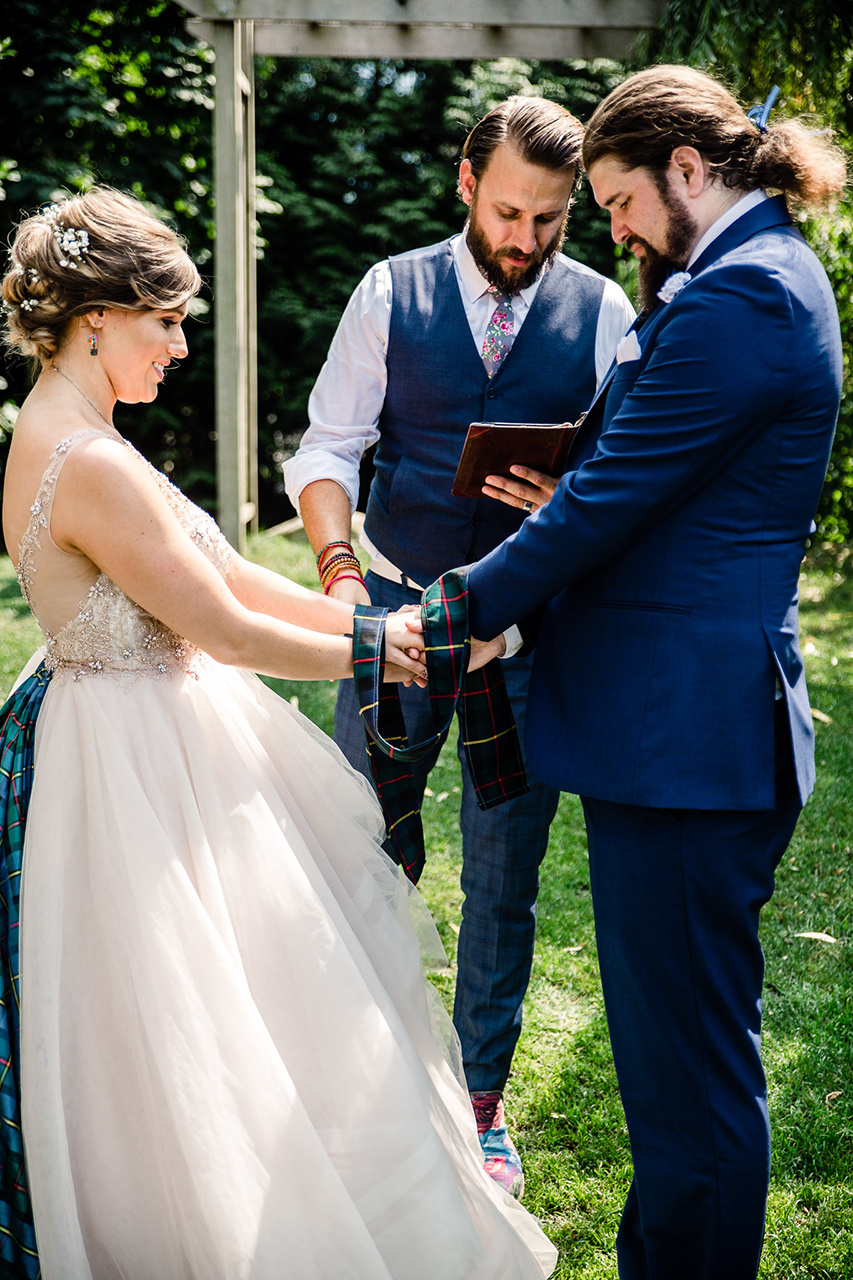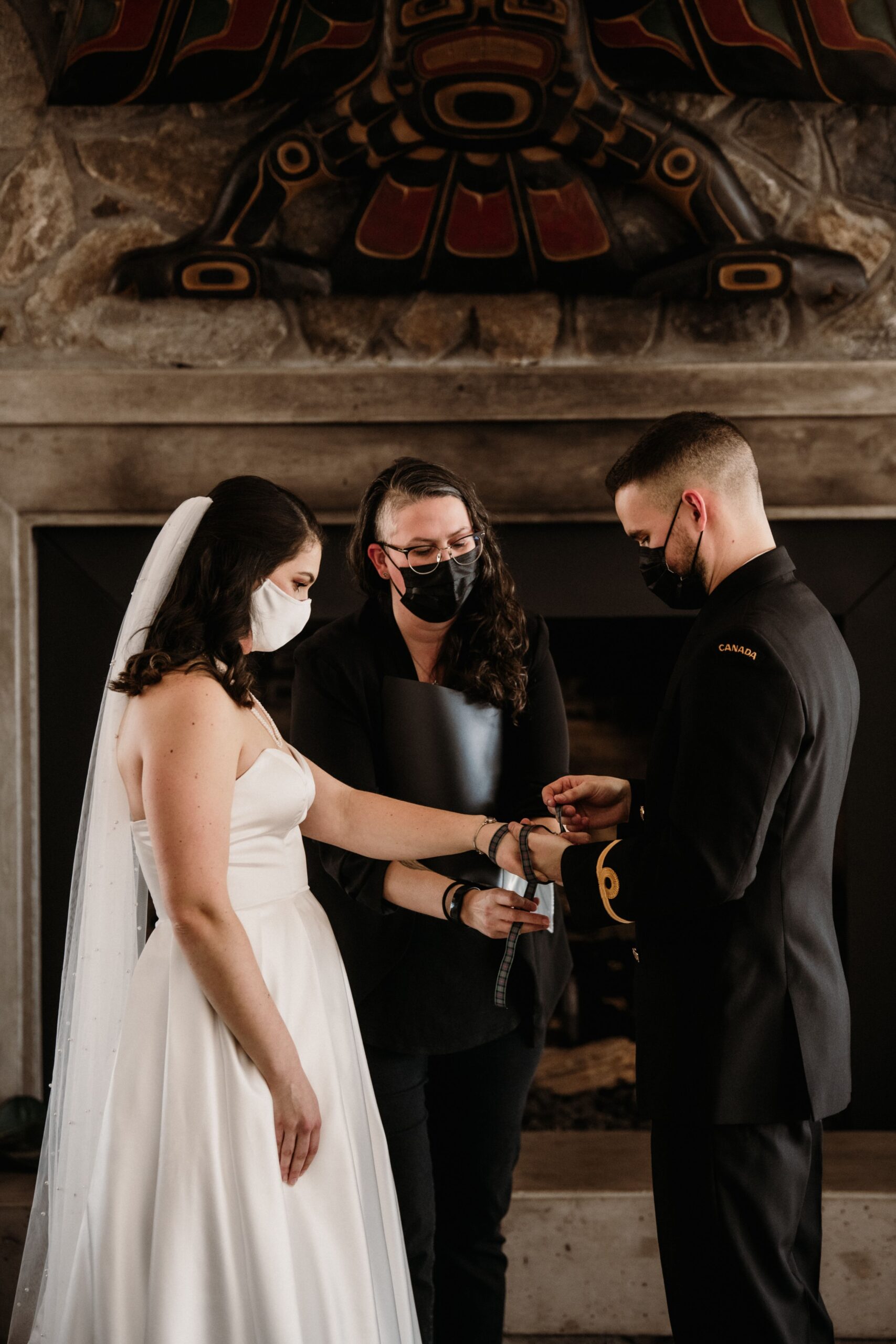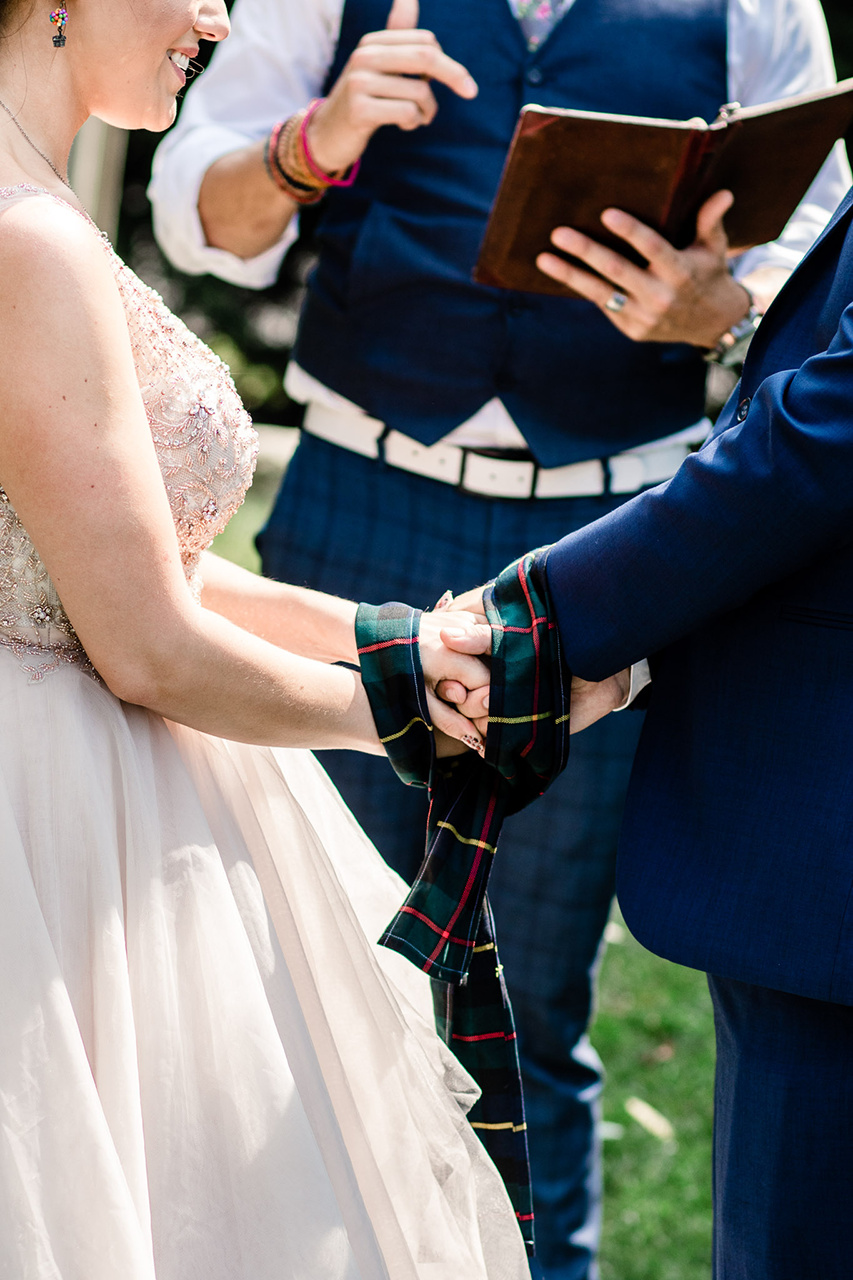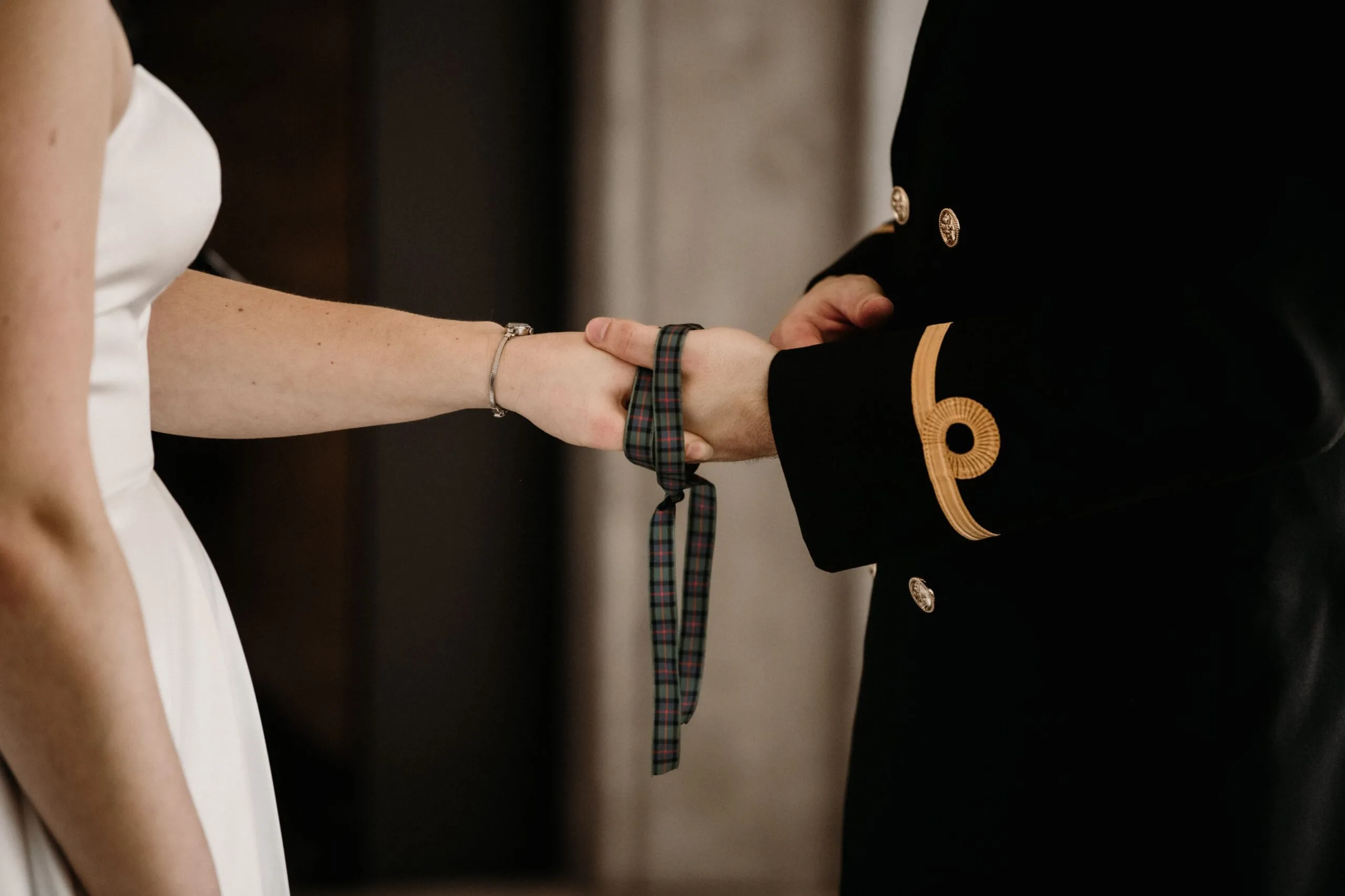Have you ever been to a wedding ceremony and seen the wedding officiant pull out a rope and tie the couple’s hands together? Well, you just witnessed a handfasting ceremony! But what is a handfasting ceremony and should you include handfasting in your wedding? Let’s find out!
What is a handfasting ceremony?
First things first, what is handfasting? Handfasting (also spelled “hand-fasting”) is a unity tradition that takes place during a wedding ceremony. The wedding officiant will wrap cords or ropes around the couple’s joint hands, tying them together, to represent their union. It’s a symbolic representation of binding two people together in marriage – and a way for couples to literally tie the knot!
Handfasting can be done with ropes, cords, ribbons or other similar materials. Generally, handfasting vows are spoken by the couple while the ropes are being tied or their wedding officiant will speak words over the tradition from a handfast ceremony script.
Where did the handfasting ceremony come from?
Handfasting is a Celtic ritual dating back to 7000 BC. However, in ancient Ireland, handfasting was used to mark an engagement, not a wedding. When a couple wanted to get engaged, they would visit a priest who would conduct a handfasting ceremony with them. This would be the couple’s public declaration of their intent to marry and their hands would stay tied until midnight.
After a year of engagement, the couple would revisit the priest and either move forward with their wedding or choose to part ways and find new romantic partners.
Handfasting is also seen in ancient Viking wedding traditions, traditional pagan weddings and Wiccan marriage celebrations. But nowadays, couples from all cultures are choosing to include hanfasting in their wedding ceremony.

What happens during a handfasting ceremony?
Typically a handfast ceremony will follow this order:
- Your wedding officiant presents the cords for handfasting and explains to your guests what handfasting is all about.
- You and your partner will join hands. Some couples choose to cross both hands (your right hand takes their right hand, then your left hand takes their left hand) while others join one hand each, but you can join hands however is most comfortable for you.
- Your wedding officiant will read from their handfasting ceremony script as they tie the cords around your wrapped hands. Traditionally, three cords are braided together but you can choose to use more cords or just one. Note, you may also have a guest of honour perform this part of the ceremony.
- (optional) You and your partner can exchange special handfasting vows while your hands are joined together.
When should handfasting take place during a wedding ceremony?
Handfasting usually takes place towards the end of your wedding ceremony and typically before the ring exchange. However, you can work with your officiant to come up with the best timing for you when you outline your ceremony. Keep in mind who will be involved in the handfasting ceremony and how long you’ll be comfortable not being able to scratch your nose!
You could also save handfasting for another time, such as your engagement party or vow renewal.
When do you get to take the handfasting cords off?
Good question! While ancient couples stayed tied up until midnight, you’ll likely want a bit more freedom than that to enjoy your wedding day with both hands.
Most modern couples remove the cords for handfasting immediately after the handfast ceremony is over or at the end of their wedding ceremony. In order to maintain the symbolism, it’s recommended that you try to slip out of the knots, rather than untie them. If that’s important to you, make sure you tell the person tying the cords around your hands not to make them too tight!

What handfasting vows do you say during the ceremony?
Handfasting vows can be exchanged by the couple while their hands are joined or spoken by the wedding officiant presiding over the handfasting ceremony.
For example, your wedding officiant could say,
“This cord of ribbons symbolizes so much. It is your life, your love and the eternal connection that the two of you have found with one another. The ties of this handfasting are not formed by these ribbons or even by the knots connecting them. They are formed instead by your vows, by your pledge, your souls and your two hearts, now bound together as one.”– Source: For This Joyous Occassion
For more pagan wedding vows, check out this link!
If you wish to exchange handfasting vows with your partner while your hands are joined, you could say,
“Upon this day, our hands we bind,
A symbol of our hearts entwined.
To witness this, we ask of thee,
Our union forever blessed be.”
– Author Unknown
Or you could say,
“Across the years I will walk with you
in deep green forests; on shores of sand.
And when our time on earth is through,
in heaven, too, you will have my hand.”
– Robert Sexton, The Promise
You may also choose to exchange your regular wedding vows during your handfasting ceremony. For more vow inspiration, check out our list of traditional vows, modern vows and FREE vow guide for writing your own personal vows!
Should you include handfasting in your wedding ceremony?
If the symbolism or cultural tradition of handfasting is important to you, your spouse or your families, you may want to include it in your wedding ceremony. As always, we believe you should only include things in your ceremony that are meaningful to you and feel authentic to who you are.
If you’re not sure if you should include handfasting or have never seen it done before, we encourage you to talk with your wedding officiant. They may have experience with handfasting and be able to offer some perspective. You could also watch videos of handfasting ceremonies online to get an idea of what yours could look like.

How can you make a handfasting ceremony meaningful to you?
We’re all about adding meaning to your wedding ceremony by personalizing it as much as possible. Here are some ways you can make handfasting and tying the knot unique to you:
- Involve family members or close friends. Instead of having your wedding officiant tie the cords around your hands, you could ask a family member or close friend to do it. You could even have a few special guests involved, each tying a separate cord around your hands. Just make sure everyone knows not to tie them too tight!
- Use special cords. Bring more meaning to your handfasting ceremony by using a special cord or handfasting ribbon, such as one used by other family members at their weddings. You could also use a cord made out of special fabric, such as grandma’s wedding dress, or purchase a cord in specific colours, such as the colours of your home country’s flag.
- Exchange vows. Handfasting becomes so much more meaningful when you take the time to exchange vows while your hands are joined. You could even come up with a vow or promise for each cord that is tied around your hands. Check out our vow resources above!
- Display the cords as a keepsake. Assuming you were able to successfully remove your hands from the cords without undoing any of the knots, you could then display the tied cords in your home. It could be your everyday reminder of the love that ties you two together.
Whether it’s handfasting or another unity tradition, your Young Hip & Married wedding officiant will help you design a custom wedding ceremony that’s true to you two. Get in touch to learn about our ceremony packages and book your officiant today!
